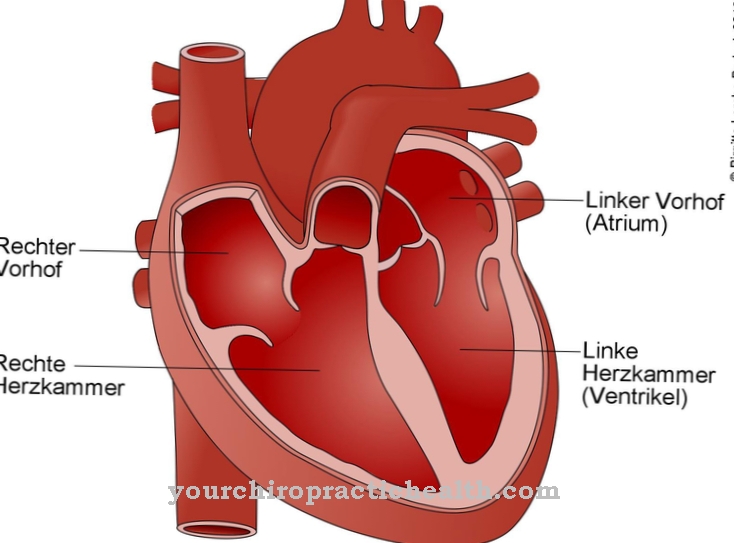Choroid plexus is the name for a plexus of veins that is located in the cavity system of the brain. The plexus is important for the production of liquor.
What is the choroid plexus?
The choroid plexus is a branched plexus of blood vessels in the ventricle (cavity system) of the human brain. He is also as Choroid plexus or Choroid plexus known.
The brain has four ventricles, each of which is equipped with such a vein network. They are also called villi bulges and are responsible for the production of the cerebrospinal fluid (cerebrospinal fluid). This so-called brain water is a colorless, clear liquid that is similar to the tissue fluid in the brain. Most of the liquor is produced by blood ultrafiltration.
Anatomy & structure
The choroid plexus is composed of an indentation of the pia mater (soft meninges). This is covered by ependymal cells and has blood vessels. The ependymal cells have their origin in the neural epithelium. The neural epithelium first produces neuroblasts. This is followed by glioblasts and finally ependymal cells. The ependyma lines the neural tube and the central canal.
As the human brain develops, the endbrain grows much faster than the diencephalon. This causes the soft meninges of both hemispheres to lie on top of each other, which results in a meningeal duplication known as the tela choroidea. What is meant is a connective tissue plate that spans between the diencephalon and the hemispheres. At the lateral edges, the pia mater forms villi for the plexus of the lateral ventricle. In addition, the roof of the third ventricle is covered.
In this region, two rows of vascular villi penetrate the ventricular lumen and create the actual plexus. The plexus of the fourth ventricle is also created by a duplication of the soft meninges. The lower surface of the cerebellum is attached to the surface of the hindbrain (rhombencephalon).
Two layers form the choroid plexus. These are the lamina epithelialis (plexus epithelium) and the lamina propria (tela choroidea). The squamous epithelium is composed of the ependymal cells, which are special glial cells. It usually has a cubic shape, but can also be cylindrical or flat. The apical cell poles are equipped with 30 to 60 cilia per cell. There is also a pronounced population of microvilli. Macrophages, also known as Kolmer cells, are located on the surface of the squamous epithelium. The Tela choroidea is a special form of the soft meninges. It has a large number of collagen fibers and is traversed by capillaries.
The choroid plexus is located on the inside of the lower horn, the central pars of the lateral ventricles and in the roof of ventricles III and IV. At the end of the fourth ventricle, a part of the choroid plexus protrudes from the foramen luschkae, also called the lateral aperture. Because of its shape, this area bears the name Bochdalek's flower basket. Via the foramen interventriculae there is a connection between the choroid plexus of the III. Ventricle as well as that of the lateral ventricle.
Function & tasks
One of the most important tasks of the choroid plexus is the production of the liquor. For this purpose, sodium ions are transported to the plasma membrane of the plexus epithelial cells by sodium-potassium-ATPase (sodium-potassium pump). Water and chloride ions connect through ion and chloride channels. Aside from the ions, the choroid plexus also secretes various nucleosides, vitamin C, vitamin B12, glucose, transthyretin and leptin.
Another function of the choroid plexus is the formation of the blood-liquor barrier. Parts of the blood-liquor barrier are the endothelial basement membrane, the plexus epithelial cells, which have their own basement membrane, and the fenestrated endothelium. While larger peptides and molecules cannot get through the fenestrated areas of the endothelium, smaller particles can cross the barrier. The absorption and detoxification of the brain water is also important. Medicinal active ingredients such as barbiturates and leukotrienes, bile salts and bilirubin are directed through the MDR 1 detoxification system (Multi-Drug-Resistance-Transporter 1) in the direction of the Tela choroidea. There are also transporters for glutamate and organic cations and anions.
Diseases
Various diseases can occur in the choroid plexus. Choroid plexus cysts that appear in the region of the choroid plexus in unborn children are considered harmless. They have an oval or round shape and are visible on both sides.
They usually reach a size of 0.3 to 2.0 millimeters. If there are no other special features, the plexus cysts are not considered to be in need of treatment, as they have no disease value. In most cases, the cysts will go away on their own and will not negatively affect the child's health.
A rarely occurring brain tumor is the plexus papilloma. It has its origin in the covering layer of the choroid plexus. The proportion of this type of tumor in all brain tumors is only 0.4 to 0.6 percent. Children and adolescents are particularly affected by the disease. The benign tumor becomes noticeable through increased intracranial pressure, which is associated with nausea, vomiting and headaches. Sometimes the formation of a plexus papilloma is related to various syndromes such as Li-Fraumeni syndrome or Aicardi syndrome.
One of the most serious diseases of the choroid plexus is plexus carcinoma, which is a malignant brain tumor. The tumor is believed to be formed by the epithelium of the choroid plexus. Obstructions to the flow of cerebrospinal fluid lead to increased intracranial pressure, which in turn leads to nausea, vomiting and headaches. Therapy is considered difficult.
























.jpg)



